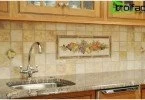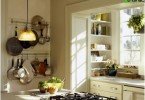It is hard to imagine how they used to do without a kitchen hood. The imagination is drawn by the smoked walls, the ceiling pretty darkened over the stove, a housewife, from time to time scurrying around the kitchen and waving a wet towel. In childhood memories, a sharp headache and the pungent smell of a burnt dish emerge. All this, without a trace, crossed out the invention of hoods, and finally allowed them to forget their production. Now it’s enough to install this useful unit, finding out before purchasing how to choose a hood for the kitchen, what criteria you need to consider and what to focus on.
Content
- What to rely on when choosing?
- Design differences kitchen hoods
- Way of work, differences
- Performance is a significant feature.
- Optimum noise level
- How to choose a hood by dimensions
- Management as a selection criterion
What to rely on when choosing?
The operating conditions of this equipment led to increased protection of devices from the negative effects of high temperature, greasy fumes and moisture. On the aspects of resistance to overheating and the effects of boiling oil vapors, there is no point in choosing the hood for the kitchen. They classify equipment according to the principle of action, performance, design features, design, and cost. An important set of additional functions, the complete list of which is far from all users need. By comparing the characteristics, type of equipment and equipment, you can easily make a reasonable conclusion, which hood for the kitchen is better in a particular case.
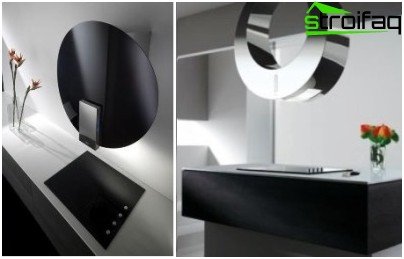
What hood to choose for the kitchen will tell you the design differences and specifications, in an abundance of modifications, an option with a suitable design is easy to find
Design differences kitchen hoods
Those who wish to equip the kitchen with a hood are offered “flat” pendant appliances, built-in equipment, dome or “fireplace”, it is also wall and corner exhaust appliances.
- Flat hanging devices are mounted above the hob. A cabinet can be located above the equipment, since there is no need to connect a flat hood with a ventilation duct. They are predominantly equipped with simple acrylic filters that adsorb only fat. In order not to change the acrylic filter every 4 months, you can put a metal hood in the hood, which you just need to periodically wash. Flat hoods – the least powerful technique considered obsolete.
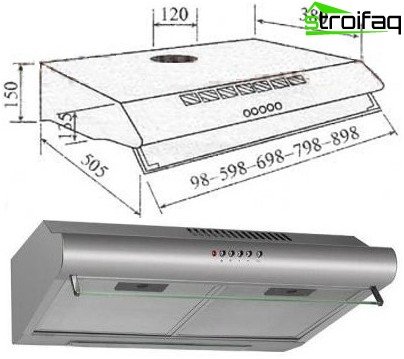
“Flat” hanging hoods – the cheapest, not too productive option for small rooms, outdated
- Built-in equipment is installed in specific hanging cabinets so that their presence can be determined only by the presence of a working exhaust surface above the stove. Most modifications have a pull-out panel, due to which it is possible to increase the intake area of polluted air mass. This is a more productive equipment equipped with a metal filter..
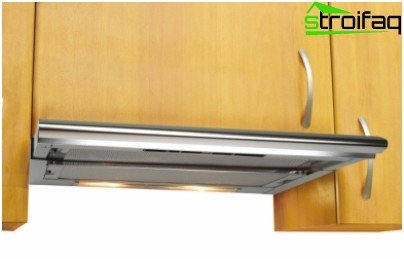
Built-in appliances for hoods are installed in kitchen cabinets, their presence is almost imperceptible, they do not affect the general perception of the interior
- Dome exhaust technology resembles a part of a chimney chimney. Among the latest modifications there are options trimmed with glass, natural wood. Whether an extractor hood is needed in a kitchen with a similar design determines the interior, although it is absolutely easy to select equipment with a suitable design in the proposed assortment. True, the domed equipment in demand has a lot of differences in technical characteristics, which mainly determine the choice.
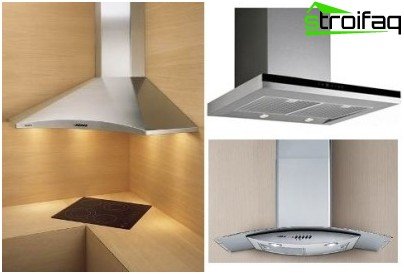
The choice of hoods for the kitchen: left corner hood, right innovative wall-mounted models
These are the most common types of hoods for the kitchen, in addition to them there are still tabletop models designed to provide additional cooking modules. Usually they are placed between the grill and stove, the proximity of the installation ensures the quality of cleaning.
Of the above types, compact built-in options with fans are the most popular, because they organically fit into any design picture and do not clutter up the space at all.

What hood in the kitchen to choose? many people prefer compact built-in models with a pull-out panel, due to which the surface area increases
Way of work, differences
Solving the problem of which hood to choose for the kitchen, you should pay attention to the fundamental differences in the operation of technical systems. These devices can perform:
- cleaning, i.e. recirculation of contaminated air mass, passing the incoming stream through the filter and returning it back;
- air intake without filtering contaminants, followed by its output into the ventilation system.
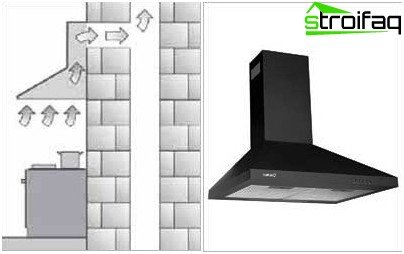
The principle of operation of the hood, which draws in contaminated air mass and leads it into the ventilation duct
Most of the latest models perform both retraction and circulation, so that the owner can independently choose a priority mode for him. If the connection to the central ventilation is not feasible due to the remoteness of the ventilation duct, due to the too time-consuming process of summing up and an unaesthetic result, the purchased unit will perfectly perform only filtering. However, one should not forget that cleaning without a charcoal filter will not eliminate odor, and it has a weaker effect than drawing it into the ventilation.
It is believed that the best hoods for the kitchen are equipped with reusable aluminum filters. Acrylic options are recognized as the most impractical, because after pollution they need to be thrown away. Charcoal filters that eliminate odors unpleasant for others are supplied separately..
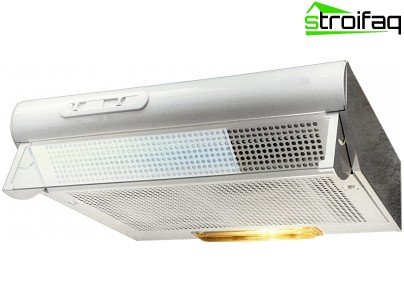
An acrylic filter is not without reason recognized as the most impractical: every 3-4 months it needs to be replaced, it is best if the filter has a metal filter installed – it needs to be replaced after 2-3 years, but it needs to be washed regularly
Performance is a significant feature.
Different models can pump from 200 to 1200 m? / H. However, the top rating of hoods for a kitchen of decent quality is far from the most powerful equipment, but appliances with a capacity of 500 m? / Hour.
To calculate the required performance, multiply the volume of the room by 10 (according to SES standards, the amount of air exchange). The result must still be multiplied by 1.3 for the stock. A certain margin of productivity will provide excellent cleaning without using the maximum mode, thereby prolonging the life of the equipment, and at the same time the noise level will be reduced.
Note. In the data sheet of devices that perform both diversion and restoration, the power of operation in the withdrawal mode will be indicated. Cleaning will be 40% weaker due to loss of power when running through a filter.
Optimum noise level
To the general regret of the non-oppressing monotonous “buzzing” hoods does not exist. You can only choose the optimal modification, combining sufficient performance with the least sound negativity. The quietest hood for the kitchen is equipped with a motor placed in a housing made of soundproof plastic, not in contact with the main body of the equipment due to the presence of special gaskets. In the technical passport of “quiet” devices, values from 36 dB will be affixed.
It is possible to reduce the level of sound waves due to the functionality of powerful fans operating at low speeds.
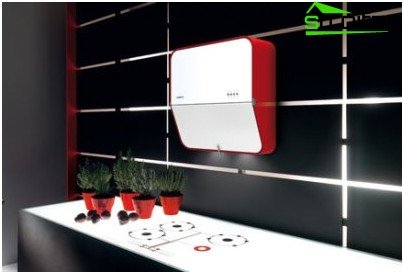
The rating of hoods for the kitchen is headed by “low-noise” models, the quietest hood for the kitchen will produce a sound no more than 36 dB (decibels)
How to choose a hood by dimensions
The area of the working surface of the hood should be equal to the area of the plate, it cannot be less, it can be slightly larger. If the size of the selected device is “not enough”, it is advisable to prefer either a built-in option with an additional retractable panel, or larger equipment.
Management as a selection criterion
Another question: how to choose a hood for the kitchen with a perfectly functioning control?
- The slider type or slider is located at the bottom of the equipment, which is not very attractive in terms of decorative aspects and inconvenient. In addition, it is often salted.
- Button version with traditional buttons.
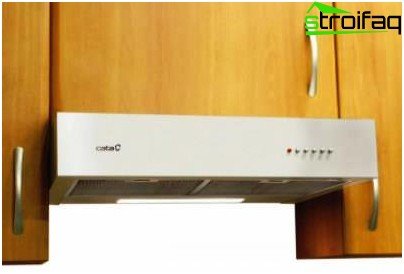
The type of control is an important selection criterion that guarantees trouble-free operation of the device and ease of use, therefore a simple reliable button option is still popular
- The touch view is convenient, but voltage surges typical of the domestic network can cause the breakdown of expensive equipment.
- The “pseudo-sensory” option is recognized as the most rational, since its micrics are well protected from clogging..
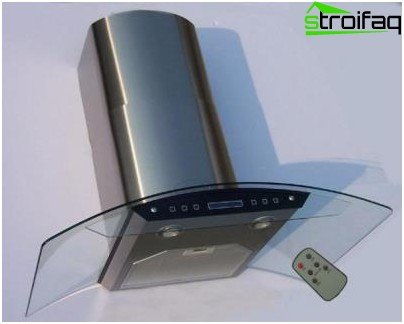
A number of models of kitchen hoods are controlled using remote controls, whether the consumer needs this option, it is up to him to decide
Of course, sellers of household appliances will tell you what you need to pay attention to when choosing. The truth should not be forgotten that their opinion is often adjusted by the desire to sell stale or more profitable goods.
Information about the types and differences of appliances, about what hoods for the kitchen are, will help you choose the most suitable model, based on your own idea of priorities. It’s better to go to the store, armed with information about the strengths, weaknesses and characteristics.


